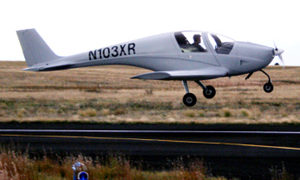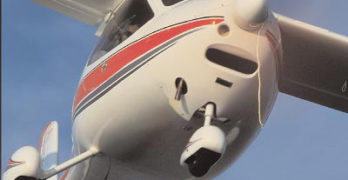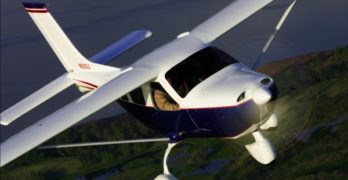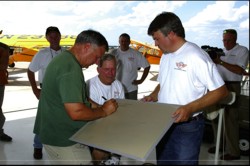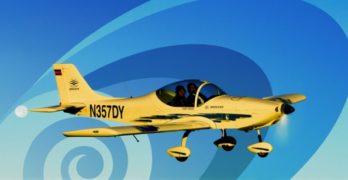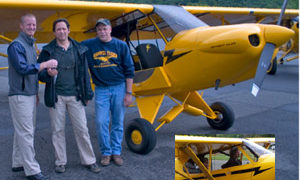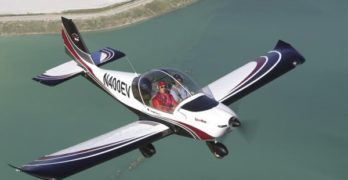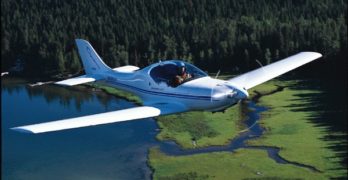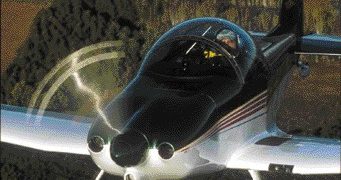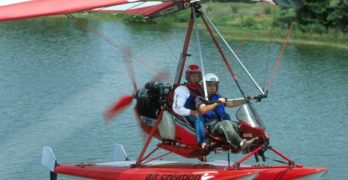On October 16th, Nexaer took a first flight in their new LS1, an LSA designed precisely for Sport Pilot. Lifting off at Meadow Lake Airport in Peyton, Colorado, test pilot Bill VonDane followed a conservative test plan of crow hopping just a few feet above the runway, setting back down on the far end. Nexaer boss Paul Klahn plans to show the new model in the LSA area of AOPA Expo in Palm Springs Nov. 9-11. *** LS1 grosses at 1,320 lbs., has a 750-lb. empty weight (depending on options), 27 gallons of fuel, and each seat is a generous 21 inches wide. Nexaer says engine choices include two Jabiru models, Rotax 912, Continental O-200, or Lycoming O-235 (though the latter may cut useful load). LS1 is described as a “no-flap design for…reduced pilot workload.” Dual full controls are available, but standard left-seat-only controls produce an interior more closely resembling an automobile.
Search Results for : MG 21
Not finding exactly what you expected? Try our advanced search option.
Select a manufacturer to go straight to all our content about that manufacturer.
Select an aircraft model to go straight to all our content about that model.
Flight Design CT2K
A Bold Yet Efficient Euro-Designed Light-Sport Aircraft
Flightstar imports the CT2K in anticipation of the light-sport aircraft rule.
As FAA’s proposed light-sport aircraft
rule looms ever closer, one
of the first aircraft that will likely
fit the field and be recognized by American
pilots is Germany’s CT. For the U.S.
market, and with a nod to the new millennium,
producer Flight Designs has
renamed the model as the CT2K.
“CT” stands for Composite Twoseater.
It is certainly not alone in being
“white, glass, and built overseas,” a
theme that emerged at EAA AirVenture
Oshkosh 2002. But the design was a
leader in the move from tube-and-rag
ultralights to the modern microlights of
Europe. And it distinguishes itself in a
number of ways that we’ll explore in
this review.
My experiences flying the CT on two
occasions were both with Europeanbased
check pilots. The most recent
opportunity was with Allistair Wilson,
formerly a major with the Royal Irish
Regiment in Northern Ireland.
Jabiru J250: A Great Cross Country LSA
What’s that airplane with the funny sounding name?
The question arises when pilots, unfamiliar with the new
brands introduced by the light-sport aircraft (LSA) category, try
to comprehend the name Jabiru.
“And this airplane company also makes its own engine?”
This second question frequently follows the first. Jabiru USA’s
Peter “Pete” Krotje and his staff must tire of the explanation.
“It’s JAB-i-roo,” I heard Pete reply patiently one day at EAA
AirVenture Oshkosh 2005. “And, yes, the company makes both
the airframe and engine.”
So begins the tale of this new airplane from the country down
under famous for kangaroos and cowboys who speak English
in a distinctly different way. Designed by Jabiru Australia of
Bundaberg West, Australia, the J250 and J170 recently earned
special light-sport aircraft (S-LSA) certification, which the
Calypso hopes to do soon as well.
It’s A Little Big Plane
As you walk up to the
J250, this modern, composite cruiser
looks like a small airplane, yet entering
the J250 is easy and, once inside, the
cockpit is surprisingly roomy, especially
given its enormous luggage area.
Bringing the Legend Home
RICH GIANNOTTI
I may be the only person who attended
Sun ‘n Fun and EAA AirVenture Oshkosh
this year with my airplane without it leaving
the ground. Why? Because my uncovered
fuselage was on display at Sun ‘n Fun in
American Legend Aircraft’s booth, and the
whole airplane was at Oshkosh, but not
ready to fly.
That changed on August 21 when my
friend, Rudy, and I traveled to Sulphur
Springs, Texas, to pick up my new Legend
Cub, serial number 1003, N77355, and
Legend’s first customer airplane.
We arrived at the American Legend’s
facility on Sunday afternoon as several
people were putting the finishing touches
on it. Darin Hart, one of the principals of the
company, was applying that cool “Legend
Cub” decal on the tail. Several others were
hovering here and there.
Monday morning, August 22, brought
the full Legend staff to bear on the airplane.
The FAA was to arrive mid-morning to issue
the certificate needed to allow a test flight.
Breezing Along
Like American
ultralights, European
microlights have paved the way
to a new breed of aircraft for European
fliers. Residents of the European community
don’t have the sport pilot/light-sport aircraft
(SP/LSA) rule, but they know how to build the planes
that serve the market.
Comco-Ikarus is one of Germany’s most
established microlight builders. After a
long and successful run with its C22
and C42 airplanes, the company,
based in Hohentengen in
southwest Germany, is
ready to run in LSA
circles with its
new Breezer.
Compared to the C22 and C42,
which is still being sold in Germany and
the United States, the Breezer is clearly
an original design. The Breezer has a
metal wing and tail, whereas the C42
has a fiberglass fuselage and its wings
are constructed of aluminum tubes and
covered with an advanced sewn textile
called GT-Foil, a Kevlar-based material.
The Breezer is a low-wing airplane,
whereas the C42 is a high-wing; the
C42 is strut-braced, while the Breezer
is cantilevered.
CubCrafters Delivers First Two SLSA Sport Cubs
Their entry has taken longer than two preceding sellers of Cub replicas under the LSA rules, but CubCrafters has taken the time to get it just right. On Thursday September 21st, the Yakima, Washington-based builder of the Part 23-certified Top Cub delivered its first two CC11-100 Sport Cub SLSA to customers from opposite coasts and starkly different environments. One will go to Juneau, Alaska and the other to Brooklyn, New York. Company president Jim Richmond thanked customers and employees who “worked and waited with us so patiently while we completely redesigned the airplane.” The company announced that deliveries will now take place at the rate of one per week, increasing to two per week near the turn of the year. *** The other two suppliers of LSA Cub replicas are North American Sport Aviation and American Legend; the latter will host a homecoming for 100 customers and prospects in the third week of October.
A Sporty SportsStar: Leading the LSA Parade
Being first is often good in marketing, sports, or life in general, for that matter. In the light-sport aircraft (LSA) certification race, one aircraft has already won: the Czech Republic-built Evektor SportStar. This all-metal, low-wing, bubble-canopy design was the first aircraft to win its airworthiness certificate as a special LSA (S-LSA), and no one can ever take that distinction away.
Evektor Aerotechnik appointed Sport Aircraft International of Kerrville, Texas, as its American distributor. That company is currently in the process of transitioning to Evektor America as its new trade name. At EAA AirVenture Oshkosh 2005, it exhibited a beautifully finished SportStar SE alongside Evektor’s four-seat Cobra, which is aimed at the Cirrus market. In the LSA Mall, another SportStar presented itself to thousands of visitors.
I flew the first imported version of the SportStar, then called the EuroStar, a few years ago. The day after EAA AirVenture 2005 ended, I was delighted to join Evektor America President Jeff Conrad and rocket down Wittman Field’s runway in the newest SportStar SE (special edition).
Dawn of the Dynamic
While many American pilots focus on SportPlanes™/ light-sport aircraft (LSA), sales of amateur-built kits continue. As the government crawls toward release of the new rule, the WT-9 Dynamic from Aerospool is one that might go both ways.
You might choose a fixed-gear, Rotax 912 80-hp model that U.S. importer Dan Defelici believes may meet the proposed regulation. But today you can buy a retractable Dynamic and build and fly the speedster around the U.S. under the 51% rule. Since LSA will probably not allow retractable landing gear, flying a retractable WT-9 will require more than a Sport Pilot license.
Getting Some Help
The 51% rule intends that the owner of a kit airplane should build more than half of the plane. The FAA has created extensive checklists to assure that a wide variety of kits meet this rule. Factories often do the hard parts that require jigs and other special equipment.
World’s Fastest Mustang II?
When most of us think about a fast airplane, we sketch in our minds a sleek and smooth exterior and wings that allow the graceful machine to slip through the air with the least possible resistance. We think the engine is also important and that more power is better than less.
But according to race winner Brian Schmidtbauer, up to 30% of the total drag in an aircraft can be cooling drag, or air movement through the engine compartment.
Because I often review gliders and slower powered aircraft, I’m sure I displayed a slack-jawed response to this comment. The stunned expression stayed on my face as Schmidtbauer described detail after detail about the handling of cooling air.
After an hour-long flight in his blazing Mustang II, I came away a believer. His homebuilt aircraft has beaten the likes of jet-smooth Lancairs and isn’t threatened by speedy RVs. In fact, only his buddy and RV-4 pilot Dave Anders has beaten Schmidtbauer in a race, and they’re so close that the next race might be different.
Air Création’s High-Performance Floats
Air Création is a serious company and a world-class trike builder with an impressive sales record. Their serious trikes sport beautiful hardware and numerous customized components. Right down to their trademark red color, Air Création is serious about building a remarkable trike, a series of them in fact.
So when Air Création puts a float set on the market, you can count on the fact that it was well researched and exquisitely crafted.
Now, let’s combine that with the XP-17 wing, the largest in the company’s XP series. Floats are mounted under and the wing atop a GTE trike carriage which has been in production for several years. Put this all on a lake in Florida and you have the makings of an interesting experience.
Another 20-Year Veteran
Gilles Bru and Jean Yves le Bihan founded the French company in 1982. Air Création’s dealer in Canada reports, “It has grown steadily ever since, building around 4,000 wings and 2,500 trike-units for sale in more than 50 countries.”
Today Air Créationemploys 25 people, four of whom are in the technical department designing new products, and 14 work on the production of ultralight trikes and wings.With annual sales of about $2.5 million, Air Création exports 60% of its products.
- « Previous Page
- 1
- …
- 83
- 84
- 85
- 86
- 87
- …
- 94
- Next Page »


